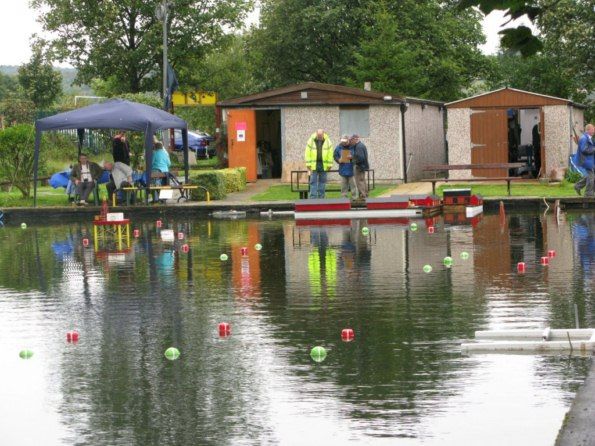The MPBA 2010 National Scale Finals
DAVE WOOLEY reports from Huddersfield

Enjoy more Model Boats Magazine reading in the monthly magazine.
Click here to subscribe & save.
The MPBA 2010 National Scale Finals were held on the 19th September 2010 at Highfields Pond, hosted by the Huddersfield Society of Model Engineers.
The pre-requisite essentials for an MPBA area or national scale course are a start and finish point, touch bar and a docking area. Apart from that, the design of the course is up to the host club, so lighthouses, oil platforms, wrecks, minefields, channels have all made their appearance at one time or another. This year the course was as challenging as that of 2009 which was organised by the Hull Society of Model Shipwrights. Now for the downside of the day – it rained! However this did not dampen the determination of the competitors to put in their best performances at this national event.
The classes and scoring
The MPBA scale rules have changed with the times and the classes available to competitors include: Open Navigation, Kit, Semi-Exact, Exact and Junior. Open Navigation has no static judging element and is also available to non-MPBA members. All classes are scored on navigating around the course, losing points for touches, plus are marked for appearance on the water, but the static judging element is not used for the Open Navigation and Junior classes. Also, in some classes there are not the traditional first, second and third places, but medals are awarded depending on the score achieved. This avoids the situation whereby perhaps the top five models are separated by just a couple of points when the scores are totalled, meaning that some competitors could then just miss out on an award, when in truth they have all done very well.
The course
Eventually, First place in Semi-Exact class went to Ian Wallett with his 1:72 scale HMS Snowflake. A new national perpetual trophy for Semi-Exact class had been donated for 2010 by MyHobbyStore via our Editor and for which the MPBA are very grateful.
As it so happened this year, the Kit class attracted most entrants and that perhaps shows how the hobby is evolving. Keith Young’s Flower class corvette HMS Charlock competing in this class achieved two clear rounds, a good on the water assessment plus a decent static score resulting in a Gold medal and the highest score of any on the day. Keith repeated this by achieving the top overall score in Open Navigation class with his Dutch lifeboat Ida Mary. There was a joint second place in this class for T. Gregg with his fishing boat Celia and R. Watton with his tug Smit Zweden, based (I think) on the Billings Smit Nederland.
Ian Kennedy has been on the model boat scene for many years and is well known for building unusual models. This day he brought along a 1:150 scale model of the side wheel frigate USS Susquehanna, the original being built in 1860 at New York. Unfortunately for Ian, the ripples on the water were just too much to allow the paddles to function properly, but it was great to see something a bit different and new.
Conclusion
The day suffered from rain, but the event ran smoothly with no glitches and that is in part due to the skills of the Huddersfield SME who count within their membership some longstanding and well known active scale modellers. Ian Wallett (Balne Moor) and Dot Wilson (Huddersfield SME) made sure the day went as smoothly as possible from an administration point of view, keeping things moving. Much other work is done behind the scenes to arrange such this event which is still the only true national radio controlled scale event with clearly defined judging and classes. Thanks to all those who came along, as without competitors there would no such event.



